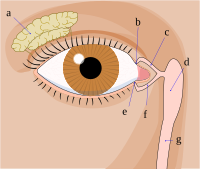
Photo from wikipedia
Nasolacrimal duct obstruction (NLDO) in children is congenital in most cases. Noncanalization of the inferior caudal end of the duct is the most common cause. Spontaneous resolution of the obstruction… Click to show full abstract
Nasolacrimal duct obstruction (NLDO) in children is congenital in most cases. Noncanalization of the inferior caudal end of the duct is the most common cause. Spontaneous resolution of the obstruction occurs in 96% of affected children in the first year in the natural course and conservative management is the mainstay.[1] Traditional treatment is a hydrostatic massage of the sac. Although there are proponents of early probing, most surgeons prefer to delay their intervention to the age of about one year. Success rates for primary probing are up to 97% during the first year.[2] Good success rates have been reported in older children as well (88% at age 12–101 months, mean 33 months).[3] Factors implicated in failure of probing include improper technique, late age of probing, anatomical variations (complex NLDO), inferior turbinate hypertrophy/ impaction, or associated nasal pathology.[4]
Journal Title: Indian Journal of Ophthalmology
Year Published: 2017
Link to full text (if available)
Share on Social Media: Sign Up to like & get
recommendations!